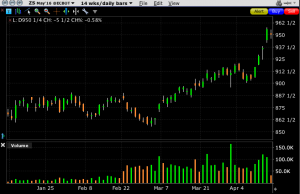- Wow, a big two sided day in Chicago markets today and it may well be that some emotion is leaving the grain and soy markets as the substantial overnight rally could not be sustained. There appears to be a reduction in open interest in soybeans and wheat which could well point to an exhaustion rally as fresh fund buying appears to be waning. The key to pricing tomorrow and in the weeks ahead will be tonight’s close and how the funds want to play next week. Markets are extremely overbought and look set for something of a correction, possibly before the end of week close tomorrow.
- The USDA has today released its weekly export figures as detailed below:
Wheat: 620,600 mt, which is above estimates of 100,000-550,000 mt.
Corn: 1,325,900 mt, which is within estimates of 1,000,000-1,400,000 mt.
Soybeans: 747,400 mt, which is above estimates of 200,000-700,000 mt.
Soybean Meal: 137.800 mt, which is within estimates of 100,000-300,000 mt.
Soybean Oil: 10,700 mt, which is within estimates of zero-20,000 mt.
- For the respective crop years to date the US has sold 17% less wheat than last year, 11.5% less corn and 7% less soybeans. Whether the USDA’s WASDE will amend forecasts, or not, remains to be seen.
- Brussels has issued weekly wheat export certificates totalling 740,653 mt, which brings the season total to 25,998,360 mt. This is 1.92 million mt (6.94%) behind last year.
- We would expect to see profit taking limit gains as the bulls take money off the table, they have windfall profits that should be banked in the absence of a central US drought materialising. Heavy W midwest rains will be welcomed in the wake of many weeks of dry conditions and this will impact market sentiment, it may slow corn seeding but progress has been rapid so far this week and we would expect some 30-35% to be in the ground.
- Argentina’s BAGE forecast their 2015.16 soybean crop at 56 million mt, 4 million mt lower month on month. This compares with the AgMin estimate of 57.6 million mt, which was a month on month reduction from 60.9 million mt.
- Finally, StatsCan put 2016 wheat seedings at 23.85 million acres, a reduction of 260,000 from last year. Canola (rapeseed) was forecast at 19.35 million acres, down 750,000 acres year on year.

